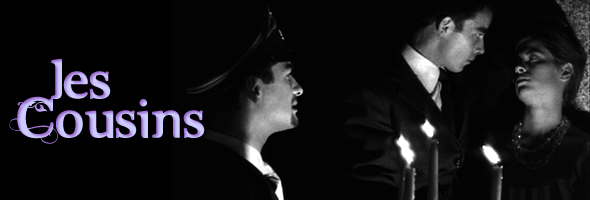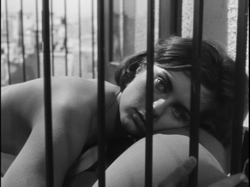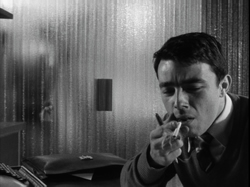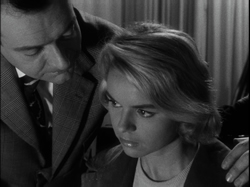
B&W, 1959, 109m.
Directed by Claude Chabrol
Starring Gérard Blain, Jean-Claude Brialy, Juliette Mayniel, Michèle Méritz, Guy Decomble, Claude Cerval
Criterion (Blu-Ray & DVD) (US RA/R1 HD/NTSC), Madman (Australia R4 PAL)

B&W, 1959, 109m.
Directed by Claude Chabrol
Starring Gérard Blain, Jean-Claude Brialy, Juliette Mayniel, Michèle Méritz, Guy Decomble, Claude Cerval
Criterion (Blu-Ray & DVD) (US RA/R1 HD/NTSC), Madman (Australia R4 PAL)
 After the positive reception for his first film, Le Beau Serge (released simultaneously on Blu-Ray and DVD by Criterion), French director Claude Chabrol pushed closer to the thriller territory that would establish his name with the more internationally recognized Les Cousins. The two male and one female leads from his previous film return here, albeit in drastically different roles as the setting shifts from the countryside to the more uncertain waters of late '50s Paris, where danger can flourish among the young without gathering much notice.
After the positive reception for his first film, Le Beau Serge (released simultaneously on Blu-Ray and DVD by Criterion), French director Claude Chabrol pushed closer to the thriller territory that would establish his name with the more internationally recognized Les Cousins. The two male and one female leads from his previous film return here, albeit in drastically different roles as the setting shifts from the countryside to the more uncertain waters of late '50s Paris, where danger can flourish among the young without gathering much notice. 
Shot with beautiful formal compositions by Henri Decaë (who lensed The 400 Blows the same year and also worked with Jean-Pierre Melville, Roger Vadim and Louis Malle), Les Cousins could justifiably be called Chabrol's first genuine masterpiece. Its clinical study of the inherent flaws in both of its cousins' world views would be embellished in many of his later films, perhaps most savagely in the apocalyptic class showdown of La Cérémonie, and here it's tied to a creepy, ambivalent view of "sophisticated" city life with art, music and film appreciation linked to decadence and a fear of sincerity or commitment. Also significant here is the presence of actress Stéphane Audran (with an atypical peroxide hairdo) working with Chabrol for the first time; they would eventually be married, and she starred in many of his finest thrillers usually as a character named Hélène.
 Like its companion Criterion release, this film was quickly embraced by European critics and enjoyed healthy regular revivials internationally; however, America treated it more indifferently after its initial playdates. A really subpar VHS with indistinct subtitles eventually came out from Interama but went out of print fairly quickly; the film was very difficult to see otherwise in an English-friendly edition until Criterion's much-needed HD release and a 2009 Australian DVD from Madman. The transfer from the original camera negative is a stunner and actually gets better as it goes along; several opening scenes have a deliberately rough and gritty texture that gradually transforms into the silky, seductive lighting and art direction as the story progresses. (And both visually and dramatically, the spare last scene is a knockout-- even if Chabrol originally had a much happier resolution in mind.) The lossless French mono audio sounds excellent, with some blasting Wagner (the same piece that inspired the previous year's Vertigo) playing a vital role. This time the audio commentary comes courtesy of film writer Dr. Adrian Martin, originally recorded for the Madman release; this one is very focused on Chabrol's role in the French New Wave, as the film came out during a crucial year that found many of the major directors first finding their voices in the international film community. He also discusses some of the film's themes which would continue throughout the director's career, including a sardonic and frequently critical view of the bourgeois lifestyle. Other extras include the French theatrical trailer and a liner notes booklet including an essay by critic Terrence Rafferty (essentially a sequel to his notes in the release of Le Beau Serge) and a very candid exceprt from Brialy's autobiography about his acting and personal relationship with Blain on several films. It's a terrific release from top to bottom and a solid intro for Chabrol newcomers as well.
Like its companion Criterion release, this film was quickly embraced by European critics and enjoyed healthy regular revivials internationally; however, America treated it more indifferently after its initial playdates. A really subpar VHS with indistinct subtitles eventually came out from Interama but went out of print fairly quickly; the film was very difficult to see otherwise in an English-friendly edition until Criterion's much-needed HD release and a 2009 Australian DVD from Madman. The transfer from the original camera negative is a stunner and actually gets better as it goes along; several opening scenes have a deliberately rough and gritty texture that gradually transforms into the silky, seductive lighting and art direction as the story progresses. (And both visually and dramatically, the spare last scene is a knockout-- even if Chabrol originally had a much happier resolution in mind.) The lossless French mono audio sounds excellent, with some blasting Wagner (the same piece that inspired the previous year's Vertigo) playing a vital role. This time the audio commentary comes courtesy of film writer Dr. Adrian Martin, originally recorded for the Madman release; this one is very focused on Chabrol's role in the French New Wave, as the film came out during a crucial year that found many of the major directors first finding their voices in the international film community. He also discusses some of the film's themes which would continue throughout the director's career, including a sardonic and frequently critical view of the bourgeois lifestyle. Other extras include the French theatrical trailer and a liner notes booklet including an essay by critic Terrence Rafferty (essentially a sequel to his notes in the release of Le Beau Serge) and a very candid exceprt from Brialy's autobiography about his acting and personal relationship with Blain on several films. It's a terrific release from top to bottom and a solid intro for Chabrol newcomers as well.
![]()